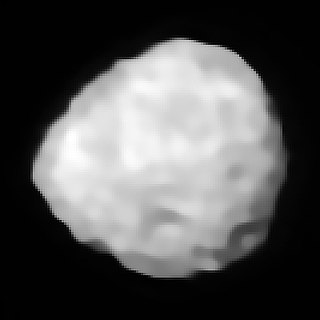
Iris is a large main-belt asteroid and possible remnant planetesimal orbiting the Sun between Mars and Jupiter. It is the fourth-brightest object in the asteroid belt. 7 Iris is classified as an S-type asteroid, meaning that it has a stony composition.

Parthenope is a large, bright main-belt asteroid.
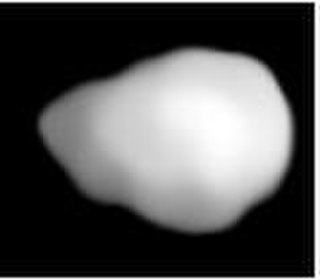
Daphne is a large asteroid from the asteroid belt. It is a dark-surfaced body 174 km in diameter is probably composed of primitive carbonaceous chondrites. The spectra of the asteroid displays evidence of aqueous alteration. It was discovered by H. Goldschmidt on May 22, 1856, and named after Daphne, the nymph in Greek mythology who was turned into a laurel tree. Incorrect orbital calculations initially resulted in 56 Melete being mistaken for a second sighting of Daphne. Daphne was not sighted again until August 31, 1862.
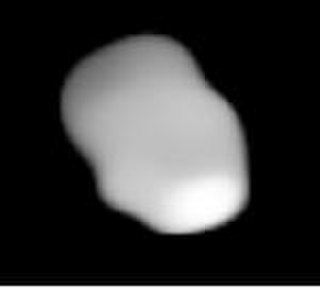
Doris is one of the largest main belt asteroids. It was discovered on 19 September 1857 by Hermann Goldschmidt from his balcony in Paris.

Diana is a large and dark main-belt asteroid. It was discovered by German astronomer Robert Luther on March 15, 1863, and named after Diana, Roman goddess of the hunt. The asteroid is orbiting the Sun at a distance of 2.620 AU with a period of 4.24 years and an eccentricity (ovalness) of 0.207. The orbital plane is tilted at an angle of 8.688° relative to the plane of the ecliptic. Its composition is carbonaceous and primitive.

Terpsichore is a large and very dark main-belt asteroid. It has most probably a very primitive carbonaceous composition. It was found by the prolific comet discoverer Ernst Tempel on September 30, 1864. It is named after Terpsichore, the Muse of dance in Greek mythology.

Beatrix is a fairly large asteroid orbiting in the inner part of the main asteroid belt. It was discovered by Annibale de Gasparis on April 26, 1865. It was his last asteroid discovery. A diameter of at least 68 kilometres (42 mi) was determined from the Beatrician stellar occultation observed on June 15, 1983. It is named for Beatrice Portinari, beloved of Dante Alighieri and immortalized by him in La Vita Nuova and The Divine Comedy.
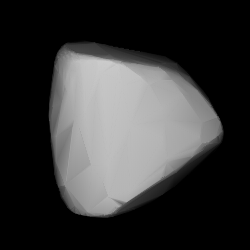
Hera is a moderately large main-belt asteroid with an orbital period of 4.44 years. It was discovered by Canadian-American astronomer James Craig Watson on September 7, 1868, and named after Hera, queen and fifth in power of the Olympian gods in Greek mythology. This is a stony S-type asteroid with a silicate surface composition.

Nemesis is a large 180 km main-belt asteroid, of carbonaceous composition. It rotates rather slowly, taking about 78 hours to complete one rotation. Nemesis is the largest member of the Nemesian asteroid family bearing its name. It was discovered by J. C. Watson on 25 November 1872, and named after Nemesis, the goddess of retribution in Greek mythology.
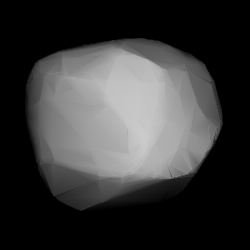
Aemilia is a large main-belt asteroid. Aemilia was discovered by the French brothers Paul Henry and Prosper Henry on January 26, 1876. The credit for this discovery was given to Paul. It is probably named after the Via Aemilia, a Roman road in Italy that runs from Piacenza to Rimini.

168 Sibylla is a large main-belt asteroid, discovered by Canadian-American astronomer J. C. Watson on September 28, 1876. It was most likely named for the Sibyls, referring to the Ancient Greek female oracles. Based upon its spectrum this object is classified as a C-type asteroid, which indicates it is very dark and composed of primitive carbonaceous materials. 168 Sibylla is a Cybele asteroid, orbiting beyond most of the main-belt asteroids.

196 Philomela is a large and bright main-belt asteroid. It is an S-type asteroid.

Dido is a main-belt asteroid with a diameter of 179±1 km. It was discovered by C. H. F. Peters on October 22, 1879, in Clinton, New York and was named after the mythical Carthaginian queen Dido. This asteroid is orbiting the Sun at a distance of 3.15 AU with an eccentricity (ovalness) of 0.058 and a period of 5.59 yr. The orbital plane is tilted at an angle of 7.2° to the plane of the ecliptic.

Eukrate is a rather large main-belt asteroid. It is dark and probably a primitive carbonaceous body. The asteroid was discovered by Robert Luther on March 14, 1885, in Düsseldorf. It was named after Eucrate, a Nereid in Greek mythology.

Regina is a typical, although fairly large, Main belt asteroid. It was discovered by Auguste Charlois on 3 August 1889 in Nice, France. The asteroid is a suspected interloper in the Eucharis asteroid family.

Palma is one of the largest main-belt asteroids. It is a B-type asteroid.

Siegena is a very large main-belt asteroid. It is classified as a C-type asteroid and is probably composed of primitive carbonaceous material.

Delia is a large Main belt asteroid. It was discovered by the French astronomer Auguste Charlois on 30 November 1894 in Nice. "Delia" is an epithet for the ancient Greco-Roman Moon goddess Artemis, for her birthplace at Delos. This asteroid is orbiting the Sun at a distance of 2.79 AU with an orbital eccentricity (ovalness) of 0.085 and a period of 4.64 yr. The orbital plane is tilted at an angle of 3.35° to the plane of the ecliptic.

679 Pax is a minor planet orbiting the Sun that was discovered by German astronomer August Kopff on January 28, 1909. It is named after Pax, a Roman goddess. It is orbiting the Sun with a period of 4.16 years and an eccentricity of 0.31.

714 Ulula is a main belt asteroid. It is orbiting the Sun near the 3:1 Kirkwood Gap with a period of 4.04 years and an eccentricity of 0.057. It was discovered by German astronomer J. Helffrich on 18 May 1911 from the Heidelberg Observatory and was named after an order of owls. The asteroid has a mean radius of 20 km and is spinning with a rotation period of seven hours. Its pole of rotation lies just 4–14° away from the plane of the ecliptic. The surface spectrum shows a pyroxene chemistry and is consistent with mesosiderites/HED meteorites.




















